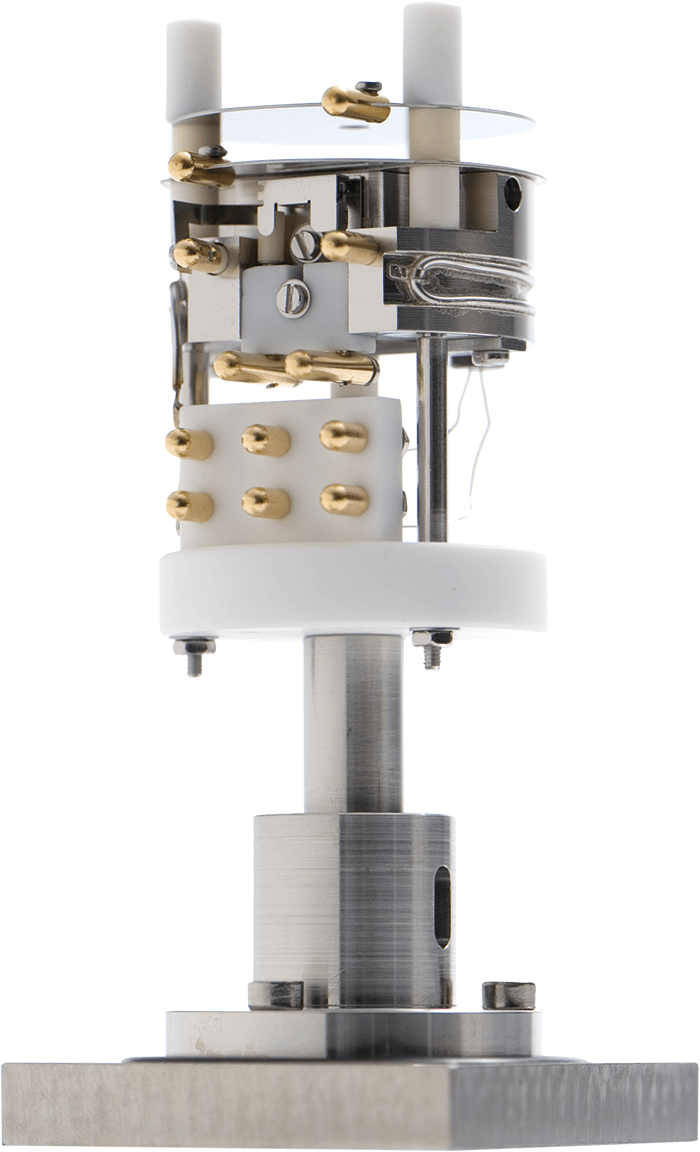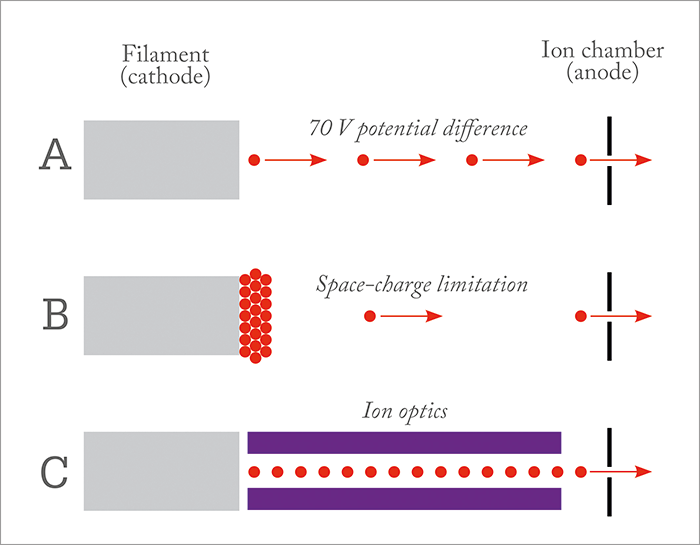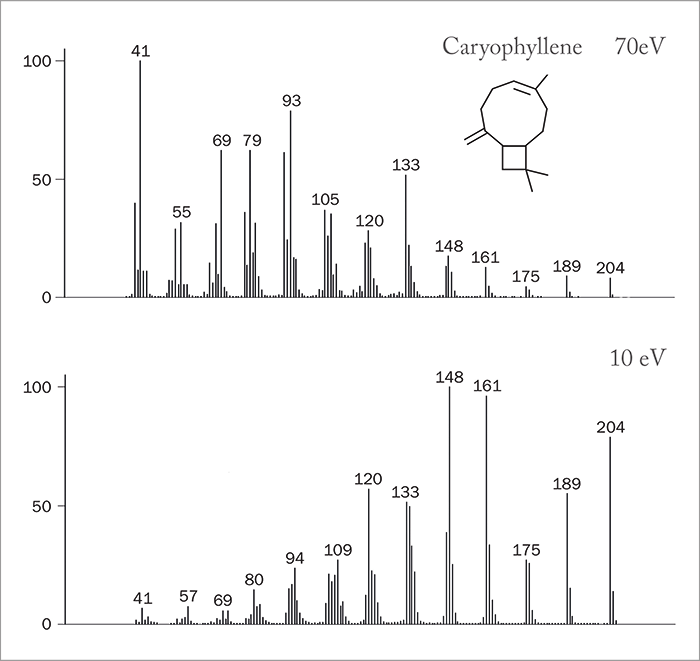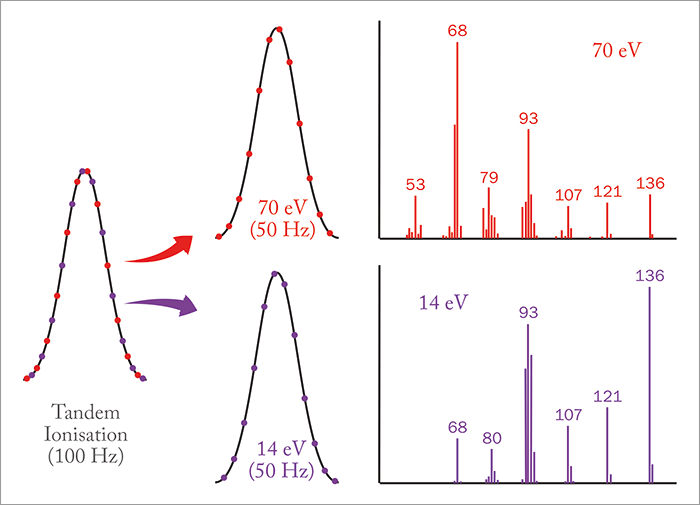The problem
Historically, the use of soft ionization for gas chromatography-mass spectrometry (GC-MS) has been limited by time-consuming hardware changes and optimization, as well as the additional expertise required for interpretation of results. These drawbacks led to its use as a ‘last resort’ rather than in routine workflows. We wanted to know: could we gain the benefits of soft ionization without the hassle?Background
Our lab chemists, like pretty much everyone running GC-MS methods, have for a long time depended upon electron ionization (EI) at 70 eV to generate the vast majority of their mass spectra. But that doesn’t mean that lower ionization energies don’t have a place in the analytical chemist’s toolbox – in fact, so-called “soft ionization” can be really useful. Lower energies reduce the amount of ion fragmentation, which means you get bigger ion fragments at the detector, and so better information on the identity of the target molecule.So why don’t GC-MS analysts routinely use soft ionization? A key factor is the inconvenience of the most common approach – chemical ionization (CI). CI uses a different ion source configuration from EI, and it needs additional pressurization and reagent gases. As a result, switching between EI and CI is impractical for most people, relegating CI to ‘last resort’ status. The story that ultimately led to the release of Tandem Ionisation in 2016 began almost a decade earlier, when, shortly after establishing Markes International, my co-founder Elizabeth Woolfenden and I became aware of the activities at Five Technologies. A start-up company based in Munich, Five Technologies were working on GC detection techniques – in particular, time-of-flight (TOF) mass spectrometry in high-sensitivity sensors. Although the core of Markes was (and remains) thermal desorption-gas chromatography (TD-MS), the majority of TD applications use MS as a detection technique; so when, in 2001, Five Technologies developed a design for a TOF mass spectrometer with a new ion source (Figure 1) that offered improved sensitivity while maintaining mass resolution, we were naturally excited. As a result, we started a partnership with them in 2004, whereby we funded research on the application of their TOF technology to GC, and in return we acquired the rights to develop, manufacture and sell the resulting products. As part of this venture we established a company, ALMSCO, through which development activities were funded. ALMSCO is led by two talented scientists – Pierre Schanen and Gerhard Horner – who are essentially independent researchers, and so less likely to fall into a common trap: “we’ll do it this way because we’ve always done it this way.”

As a result, they’ve been free to use their initiative to come up with new solutions from first principles. It was this atmosphere of innovation, together with expertise from other Markes staff members, including Nick Bukowski, that ultimately led to the launch of our TOF mass spectrometer in 2008. Known as the BenchTOF because of its compact dimensions, this instrument has proved highly popular amongst our target audiences, first in academia, then increasingly in the petrochemical, food and fragrance industries. Our customers like its high sensitivity and its ability to generate mass spectra that closely match those in quadrupole-acquired spectral libraries.
The solution
Where does soft ionization come into the story? Throughout the development of BenchTOF, we were aware that the instrument’s design would allow us to do interesting things with the ion optics at a later date. So, once the product was launched, we set about investigating options that might deliver soft electron ionization. At the time, the very idea would have sounded a strange to many analysts; after all, soft electron ionization had been tried before – and deemed unworkable. The major problem is that the smaller potential difference doesn’t effectively pull the electrons away from the filament (where they are generated). Fewer electrons reaching the ion source means that fewer ions are formed, leading to a collapse in sensitivity. Pierre and Gerhard realized that they could draw on the BenchTOF’s unique design – incorporating a gated electron beam – to overcome the problem. The concept: to use a high potential difference to accelerate electrons away from the filament, but then reduce their energy before they arrived in the ion chamber (Figure 2). The result? A steady flow of lower-energy electrons, but with sensitivity back to acceptable levels.

Once the concept had been proven on paper, it was remarkably easy to turn into reality – about eight months from the basic idea to a working demonstration! But then came the all-important period of instrument refinement, developing manufacturing processes, and beta-testing with collaborators in academia. Launched as Select-eV (also a TASIA winner in 2014), the technique allows the user to carry out runs using an ionization energy of their choice – either 70 eV “hard” ionization for regular library-matching or “soft” ionization between 10 and 20 eV. The mass spectra generated using Select-eV show significantly reduced fragmentation, depending on the molecule’s structure and the exact ionization energy (Figure 3). As well as providing stronger signals from the higher-mass fragments that enable similar compounds to be discriminated, there’s reduced interference from GC background and ionized carrier gases, resulting in much cleaner spectra. In turn, higher signal-to-noise ratios can be obtained, compensating for the inherently lower ionization efficiency (given the lower-energy electrons), and bringing sensitivity back up to the level needed for the most demanding applications. Achieving all this without hardware changes is a major benefit in busy laboratories.

Many analysts immediately saw the benefit of soft ionization with Select-eV, and were keen to obtain an instrument to see what it could do for their own samples. But almost immediately they were asking us: “Is there any way we can do soft and hard ionization in a single run?” We already knew that analysts would be familiar with the concept of “switching” between ionization modes, given the well-established positive/negative ion capability of mass spectrometers. However, we didn’t want to run before we could walk, so we focused on the core soft ionization capability before we started trying anything more sophisticated... Two years of development later and we had modified the way the ion optics worked so that the electron energies rapidly switched between soft and hard ionization, meaning that ions from even the narrowest GC peaks were generated at both energies. The most challenging aspect was actually the electronics, which had to be carefully refined to allow switching of multiple voltages at up to 100 times a second, which is necessary for fast GC separations, such as those used in GC×GC. The outcome of all this work, launched at the Analytica tradeshow in May 2016, was Tandem Ionisation. Incorporated into the BenchTOF instrument, it was able to generate two datasets in a single GC run (Figure 4) – much to the delight of our customers. Software has also been a key aspect of the project, and we made sure that the raw data could be split into two separate data files in real-time, meaning that hard and soft ionization data can be interrogated as soon as it’s generated, saving valuable time in method development.
Beyond the solution
Tandem Ionisation represents a significant breakthrough – a technology allowing low-eV ionization and regular 70 eV ionization with no inherent loss in sensitivity, no complicated hardware changes, and no need to run thesample twice. The benefits of soft ionization on BenchTOF instruments have already been demonstrated in the scientific literature; in a paper on GC×GC fingerprinting of hydrocarbons in motor oil (1), Salim Alam and colleagues at the University of Birmingham concluded that “the combination of retention times in two dimensions and mass spectra at low and high ionization energies confers unparalleled power to identify specific isomers within the chromatograms.”

And more recently, a team led by Jef Focant at the University of Liège, Belgium, used soft ionization to help identify challenging compounds in blood headspace (2). The team concluded, “The combination of low and high ionization energies [...] improved the identification of challenging compounds for blood VOC profiling.” (Read about the latest research from the Focant group at tas.txp.to/0417/SMELL). Work on Tandem Ionisation continues today – specifically on software tools to make it easier to use in high-throughput laboratories. You could say our ultimate goal is to make soft-ionization mass spectrometry an everyday tool rather than a last resort for the GC-MS analyst. Thanks to scientific insight and a willingness to embrace new ideas, I think we are well on the way to making that a reality. Alun Cole is Founding Director of Markes International, Llantrisant, UK.
2001 BenchTOF designed by Five Technologies 2004 Markes acquires BenchTOF technology January 2008 BenchTOF launched 2008 Development of Select-eV begins January 2014 Launch of Select-eV December 2014 Select-eV wins TASIA May 2016 Launch of Tandem Ionisation December 2016 Tandem Ionisation wins TASIA
References
- MS Alam et al., “Using variable ionization energy time-of-flight mass spectrometry with comprehensive GC×GC to identify isomeric species”, Anal Chem, 88, 4211–4220 (2016). LM Dubois et al., “Thermal desorption comprehensive two-dimensional gas chromatography coupled to variable-energy electron ionization time-of-flight mass spectrometry for monitoring subtle changes in volatile organic compound profiles of human blood”, J Chromat A, 1501, 117–127 (2017).




